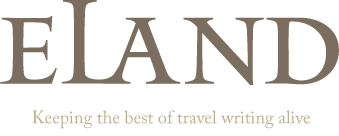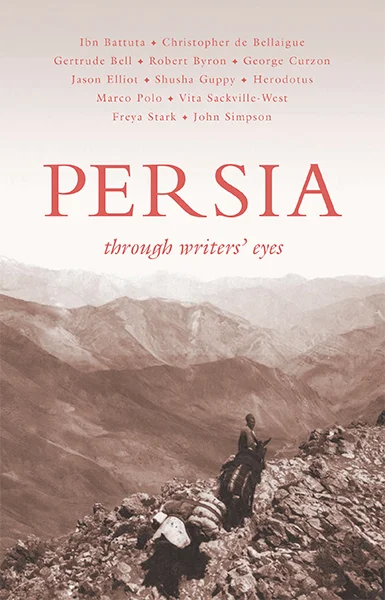Persia: through writers’ eyes
Persia: through writers’ eyes
The land of the Iranians, known to European travellers for centuries as Persia, is riven by mountain-ranges, made inhospitable by deserts, yet rich in plains, forests and jewel-like gardens. Home to the most sublime architecture in the world, and a breeding ground for poets, empires, mystics and saints, it has an enduring and invincible fascination. David Blow enriches our understanding with his knowledgeable selection of the best of three thousand years of descriptive writing. He allows us to visit the courts of Cyrus and Xerxes, to ride out with the Parthians and Sassanians and to make a passing acquaintance with both the Shah and the late Ayatollah Khomeni, with Haf iz and with Omar Khayyam.
Including: Herodotus, Aeschylus, Xenophon, Marco Polo, Ibn Battuta, Sir John Chardin, Sir James Fraser, George Curzon, Robert Graves, Harold Nicholson, Freya Stark, Robert Byron, Shusha Guppy, John Simpson and Christopher de Bellaigue
Persia: through writers' eyes
Edited, collected and annotated by: David Blow
ISBN: 978-0955010-55-2
Format: 312pp demi pb
Place: Persia/ Iran
Extract from Introduction
WHEN I WAS FIRST IN Persia many years ago I often took the bus between Tehran and Isfahan, where I was living. The buses were notoriously accident-prone, so as we set off the passengers would invoke divine protection by crying out three times, ‘Bismillah ar-Rahman ar-Rahim’ (‘In the name of God, the Merciful, the Compassionate’). I remember on one occasion as we left the modern capital behind, a smartly dressed Tehrani looked out of the window and exclaimed with feigned astonishment ‘Voy, Voy, een biyaban-e khushk!’ (‘Oh dear, Oh dear, this dry desert!’). But for me it was not an alien, arid wasteland that we were passing through. It was filled with the footsoldiers and horsemen of countless Persian and foreign armies that had crossed this land – the armies of Darius and Xerxes, of Shah Abbas and Nader Shah, and of foreign conquerors like Alexander the Great and Tamerlane. More peaceful visions also came to mind, like the entire, richly apparelled Persian court on the move as the king set off for the summer hunting grounds, and the merchant caravans moving slowly along the road with their long lines of camels and mules, perhaps bearing bales of raw Persian silk to be shipped to Europe.
As a student who had just graduated in history, I started learning Persian in order to get away from an excessively Eurocentric view of the world. I was also attracted to Persia for its long and colourful history and its high culture. When I later went out to Persia I was further captivated by its people, by their friendliness, humour and quick intelligence. I divided my time between left-wing intellectuals, who taxed me with questions about Jean-Paul Sartre, and the decadent remnants of the old Qajar aristocracy with whom
1
0/Persia - prelims and intro 24/8/07 13:13 Page 1Persia: through writers’ eyes
I could relax over an occasional pipe of opium while listening to the plaintive notes of the Persian flute. I was also soon made aware of the almost universal conviction that all Britons in Persia were spies – a belief rooted in attempts by Britain during the nineteenth and much of the twentieth centuries to pull the strings in Persia in order to protect its interests, first in the defence of India and later of Persian oil.
I hope that this book will make Persia’s past as vivid for its readers as it has become for me. There is no better way of doing this than by reading the first-hand accounts of people who spent time there. Most were Europeans who did not go out to Persia in the first instance to write about it. They went there to do a job, often as diplomats or merchants. The professional travel writer only emerged on the scene during the nineteenth century. But, whatever the reason for their presence, the picture they paint of Persia is a colourful and lively one, informative and often entertaining, perceptive and discerning, sympathetic but not uncritical.
The European accounts of Persia provide a great deal of information about the country which would not otherwise be available, as Persian sources are often seriously deficient. This is most true of the ancient period, but it also applies to later periods, particularly the seventeenth and nineteenth centuries, when European accounts are very numerous. They cover almost every aspect of Persian life, whereas the Persian sources, many of them court chronicles, are much more restricted in their scope. In addition, much of the official documentary evidence has been lost or destroyed in the course of Persia’s turbulent history. When the Afghans captured the Safavid capital of Isfahan in 1722, they are said to have thrown the entire state archive into the river.
One difficult question for which it is impossible to lay down a simple rule is when to speak of Persia and when of Iran. Until as late as the 1930s Europeans invariably spoke of Persia and things Persian, which were terms they inherited from the ancient Greeks. The Greeks used them because the empire of Cyrus, Darius, and Xerxes was founded by a federation of tribes called the Persians whose homeland in the present-day south-western province of Fars was called Parsa (in Greek Persis). These Persians belonged to the
2
0/Persia - prelims and intro 24/8/07 13:13 Page 2
Introduction
wider family of Iranian peoples, but it is clear from the inscriptions of Darius that they attached more importance to their Persian identity. The emphasis on an Iranian identity and the use of the term Iran to denote the country we know today, though within more extensive borders, was first introduced by the Sasanids, the rulers of the last empire before the Arab conquest in the mid-seventh century AD. Iran as a political term then fell out of use until revived by the Mongol rulers of the country in the thirteenth century, after which it became firmly established. The language, however, has always been called Farsi or Persian.
However, in Europe that first empire, and the Greek authors who wrote about it, made such a strong impression that the country continued to be known as Persia. This was reinforced by an educational system that gave pride of place to the study of Greek and Latin as well as by familiarity with the Old Testament of the Bible and its many references to the Persians.
As a result of this long usage, the term Persia has a richer resonance for Europeans, though this may change in time. For the present, it remains the preferred term for products of the country’s culture with a long historical tradition, so that we speak of Persian cuisine, Persian gardens and Persian carpets, but of the Iranian cinema. It also remains the more common term when speaking about the country up until the 1930s. I too have used it for this period, not least because the European writers represented in this anthology do so. In the end, there is no reason to get too exercised about the alternative usages, which an Iranian historian writing in English has likened to the difference between America and the United States. It is a matter of what feels right in a given context.
The hardest thing about putting this book together has been having to leave out, for lack of space, so much that I would like to have included. I have tried to provide as varied a subject matter as possible, as well as choosing pieces for their intrinsic quality. And like the greatest of all the seventeenth century writers on Persia, Sir John Chardin, I have borne in mind ‘what would merit the curiosity of us Europeans’.
David Blow

